Sierra de las Estancias
Almeria - Andalucia - Southern Spain
The Estancias mountains... a leading destination for rural attractions and rural villages in the mountain landscapes of Almeria. 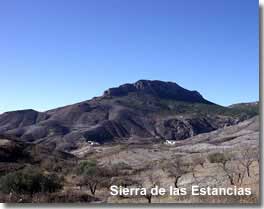
Las Estancias mountain range
Las Estancias are also known as Alto Almanzora - High Almanzora, the mountains overlooking the Almanzora valley in the south. The villages of the Estancias, which are located within the Almanzora district boundaries, include Albox, El Saliente, Oria, Partaloa, Urracal, Somontin and Lucar as well as other smaller mountainside hamlets.
The Estancias are made up of three mountainous regions, the Sierra de Oria, the Sierra del Saliente and the Sierra de Lucar, the later being best known for its talc mining industry, the mineral has been extracted from the mountains since  the early 20th century.
the early 20th century.
Due to extreme weather conditions, including intense summer temperatures, scarce rainfall, high winds, and frequent frost in the winter time, the important plant species here have adapted to their environment in order to survive, some being exclusive to the region.
There is a wealth of culture to be appreciated within the traditional hillside villages, and the stunning countryside settings are becoming popular with visitors looking for unique destinations for excursions and outdoor recreational activities such as nature walking, hiking, mountain biking, and horse riding.
Quick links - Sierra de las Estancias
- Rural properties
- Saliente sanctuary mountain retreat
- Lucar village and the Cela spring water pool
- Somontin village
- Partaloa village
Choose Sierra de las Estancias for mountain attractions
Saliente sanctuary, Cela pool, traditional mountain villages, stunning scenery, history and culture...
Rural property in Sierra de las Estancais
The villages, hamlets and countryside of the Oria, Saliente and Lucar mountains are prime locations for rural properties in Almeria, from new villas to reformed cortijos all have stunning views and offer holidays or relocation in the real Spain.
Choose Almeria property listings for rural properties in the Estancias
Exploring the Estancias mountains
Exploring the countryside or investigating the villages, the Estancias mountains are an amazing location for day trips in Almeria, my travels here have lead to some very interesting discoveries, which I have detailed below, I hope they inspire a visit to this relatively uncharted destination.

Albox
Albox, situated in the Estancias foothills, is the largest town in the area and probably the most well known by the British expatriate community, access is from the A-334 which is the main road through the Almanzora valley along the southern limits of the mountain range. This is quite a bustling neighbourhood, with a large commercial presence, both in the town centre and on the outskirt in the industrial zone.
From Albox the ALP-303 provides a mountain roadway through the Sierra del Saliente via several picturesque hamlets including Las Pocicas, Saliente and Los Cerricos and includes the captivating destination of El Sanctuario del Saliente, twenty kilometres from Albox town.
Saliente Sanctuary
El 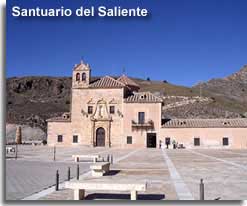 Santuario del Saliente is one of the main religious tourism sites in Almeria, an ancient monastery occupying a hilltop position in the Estancias mountains, its chapel is home to the symbolic Virgen del Saliente figurine, the virgin of the good retreat and her deserted.
Santuario del Saliente is one of the main religious tourism sites in Almeria, an ancient monastery occupying a hilltop position in the Estancias mountains, its chapel is home to the symbolic Virgen del Saliente figurine, the virgin of the good retreat and her deserted.
Every year, traditionally on the 8th of September the Romeria del Saliente fiesta is celebrated in honour of the Virgin and patrona of the municipality of Albox, she is endearingly referred to as La Pequeñica, representing the hope of a community that has found its identity after surpassing the difficulties of natural disasters, hunger, emigration and uprooting.  During the pilgrimage the Virgen del Saliente figurine is lovingly paraded through the town of Albox and carried up the mountains amid a vast procession of villagers and visitors to her home in the chapel of El Santuario.
During the pilgrimage the Virgen del Saliente figurine is lovingly paraded through the town of Albox and carried up the mountains amid a vast procession of villagers and visitors to her home in the chapel of El Santuario.
The ancient monastery building, now renovated and converted into a hostelry and restaurant, has been declared a natural monument of history.
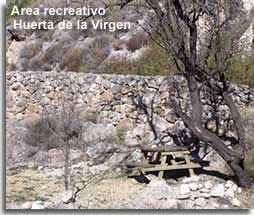
There is no need to wait till the fiesta to follow the route to the retreat, it can be taken any day of the year along the ALP-303 between Albox and Chirivel and is now a popular cycling trail.
The Area Recreative Huerto de la Virgen, situated on the hillside directly below El Santuario, is essentially a pretty picnic area with benches and tables offering access to and from the the retreat via a series of walkways and steps.
Though parking is very limited at the lower entrance to the recreational area there is plenty of parking available at the retreat. 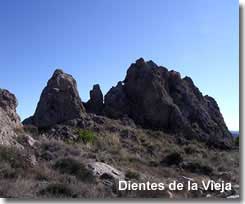
The arrival at El Santuario is denoted by the Dientes de la Vieja, literally translated, the teeth of the old woman, a remarkable collection of rocks jutting out from the mountainside in the shape of well worn teeth.
Diversifying a little from this special destination, the hamlets and villages along the route of the ALP-303 are idyllic retreats themselves, the property here, mainly old cortijos and farmhouses, many of which have been lovingly restored, 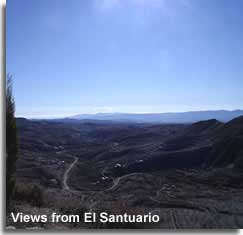 are the homes of many savvy expats who have realised the beauty of this region and have relocated to lead a rural life in the mountains, evidence is spotted along the roadside where tracks leading to the hamlets have a selection of postboxes bearing British names.
are the homes of many savvy expats who have realised the beauty of this region and have relocated to lead a rural life in the mountains, evidence is spotted along the roadside where tracks leading to the hamlets have a selection of postboxes bearing British names.
Whether cycling, walking or by vehicle I cannot recommend this itinerary enough, the views are spectacular and as far reaching as the Sierra Filabres in the south.
The destination, I have to say, is a place of utter 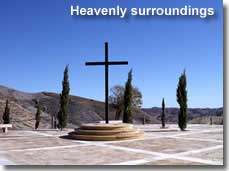 enchantment with an ancient ambiance of its significant past and I am not embarrassed to admit I was very close to tears in awe of this place and the heavenly surroundings.
enchantment with an ancient ambiance of its significant past and I am not embarrassed to admit I was very close to tears in awe of this place and the heavenly surroundings.
I visited, by car I confess, on a sunny morning in December though I vow to return in springtime when the almond blossom is said to form a magical blanket on the slopes of the valley below.
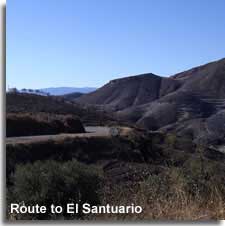
The route itself is a gradual incline though it reaches altitudes of around 1400m, the steeper sections do have road side barriers, though I do declare, the last one kilometre of road, around the side of the mountain to the entrance to El Santuario, can be walked for those without a head for heights via the recreational area mentioned above. I am proud to say that despite my previously mentioned fear I did drive this final section albeit with a little trepidation 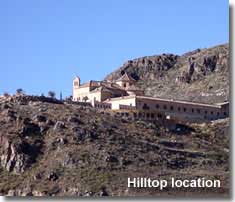 and plenty of care and attention.
and plenty of care and attention.
On my arrival Menu del Dia was being served from the mountainside restaurant, noteworthy for those wishing to experience some traditional gastronomy in what has to be one of the best restaurant settings in Almeria.
The Chapel at El Saliente is open every day except Tuesday, from 10am till 1.30pm, reopening again at 4pm.*
*Opening times establised in 2014.
External link
Provided to help visitors make the most of the area. The link will open in a separate page.
Hostelry and Restaurant Virgen del Saliente Hospederia y Restaurante, the website is only available in Spanish.
Lucar
Lucar village, in the Sierra de Lucar, clings to the side of the mountain and enjoys  traditional architecture, demonstrating the whitewashed image of a typical Andalucian village.
traditional architecture, demonstrating the whitewashed image of a typical Andalucian village.
The main square is the central focus with its town hall and church, the prominent old bell tower is seen from every aspect of the village.
An interesting viewing point, located on the edge of the village, offers vistas down the valley and across to the Tetica peak, the second highest point in the Filabres mountain range on the opposite side of the valley, the mirador is recognised by the illustrations of a goat herder, goats and a goat dog set in the landscape horizon. 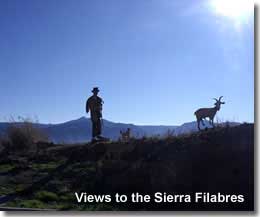
The Lucar peak, the highest in the Estancias range, has been declared a Natural Monument for its endemic species of flora, the geological location is known as Piedra Lobera, a towering limestone rock that rises above the landscape to 1722m above sea level.
Signposted on the approach to Lucar, the twelve and a half kilometre Piedra Lobera trail can be taken by vehicle or on foot, though the road is unmade the terrain should not cause a problem for off road vehicles.
The mining heritage of the region is very apparent in the mountains surrounding Lucar 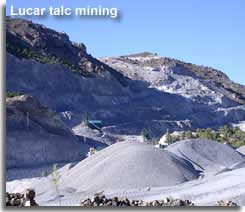 and the neighbouring village of Somontin.
and the neighbouring village of Somontin.
In the early 20th century, the talc yield from the Estancias boasted a majority proportion of the overall production levels in Spain.
Mining activity can be seen on the route to the Piedra Lobera.
Lucar is signposted from the A-344, along the AL-6100 via Cela.
Cela village and spring water pool
Cela village, located along the 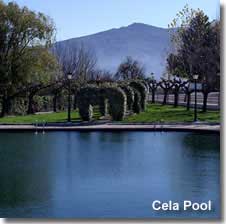 route between Tijola and Lucar, is home to the Cela natural spring, an essential resource that has been utilised throughout history.
route between Tijola and Lucar, is home to the Cela natural spring, an essential resource that has been utilised throughout history.
The spring produces thermal waters of around twenty three degrees all year round, and today its has been applied to create a shallow pool of naturally warm water and an outdoor bathing spot at the foot of the mountains.
Cela village and pool are signposted from the AL-6100, there are a couple of tapas bars and restaurants right next to the pool, open throughout the summer months, providing convenient refreshments.
External link
Provided to help visitors make the most of the area. The link will open in a separate page.
Piedra Lobera Natural Monument further information on the flora of Piedra Lobera from the Junta de Andalucia website, detailed in English.
Somontin
Somontin mountainside pueblo, signposted from the main A-334 along the AL-6103, is a must do destination for the extensive vistas that can be appreciated from the Balcon de Almanzora Mirador, a special viewing point situated on the edge of the village.
The views down to the Almanzora valley are widespread and include 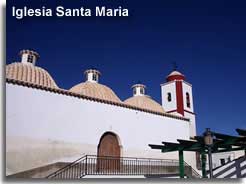 the valley villages of Olula del Rio, Macael, Purchena, Armuña, Tijola, Seron, and the Mirador de Sufli, the panoramic scenery also encompasses the Filabres mountains and the Tetica peak situated on the opposite side of the valley.
the valley villages of Olula del Rio, Macael, Purchena, Armuña, Tijola, Seron, and the Mirador de Sufli, the panoramic scenery also encompasses the Filabres mountains and the Tetica peak situated on the opposite side of the valley.
The mirador and plaza is overlooked by the 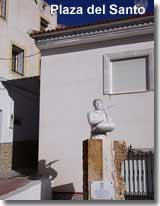 17th century renaissance style village church, Iglesia Santa Maria.
17th century renaissance style village church, Iglesia Santa Maria.
The mining history of the mountains is acknowledged in the village main square, Plaza del Santo, where a statue of a mine worker was erected in 2007 in honour and respect of the miner workers of the Estancias.
This is a pretty village with steep narrow streets 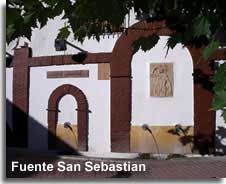 and several fountains and water features, in particular, at the foot of the village, in Plaza San Sebastian is the Fuente San Sebastain, derived from a mountain spring, the fountain is named after the patron of Somontin, whose fiesta is celebrated in mid January.
and several fountains and water features, in particular, at the foot of the village, in Plaza San Sebastian is the Fuente San Sebastain, derived from a mountain spring, the fountain is named after the patron of Somontin, whose fiesta is celebrated in mid January.
Along the AL-6103, on approach to Somontin, there are several pathways heading into the countryside, signposted Parajes, possible beauty spots or places of interest, and an opportunity for further exploration.
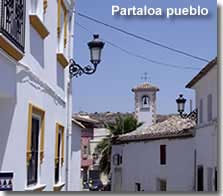
Partaloa
The A-399 mountain route, access to which is from the main A-334 just outside of Albox, offers an option to discover the mountainous landscapes of the Sierra de Oria, this road goes via the hillside pueblo of Partaloa en route to Oria in the north of the Estancias range. 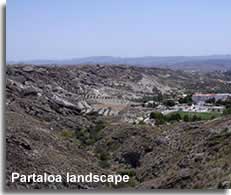
Partaloa pueblo is set in a valley in the mountain foothills beside the Rambla de Arquillos. The setting is quite remarkable, flanked by a ridge of stone that, in several places, has quite literally broken off and crashed down the slope into the valley, the landscape is scattered with huge boulders.
The Sierras of Almeria
An introduction to the mountains of Almeria including location map ![]()







